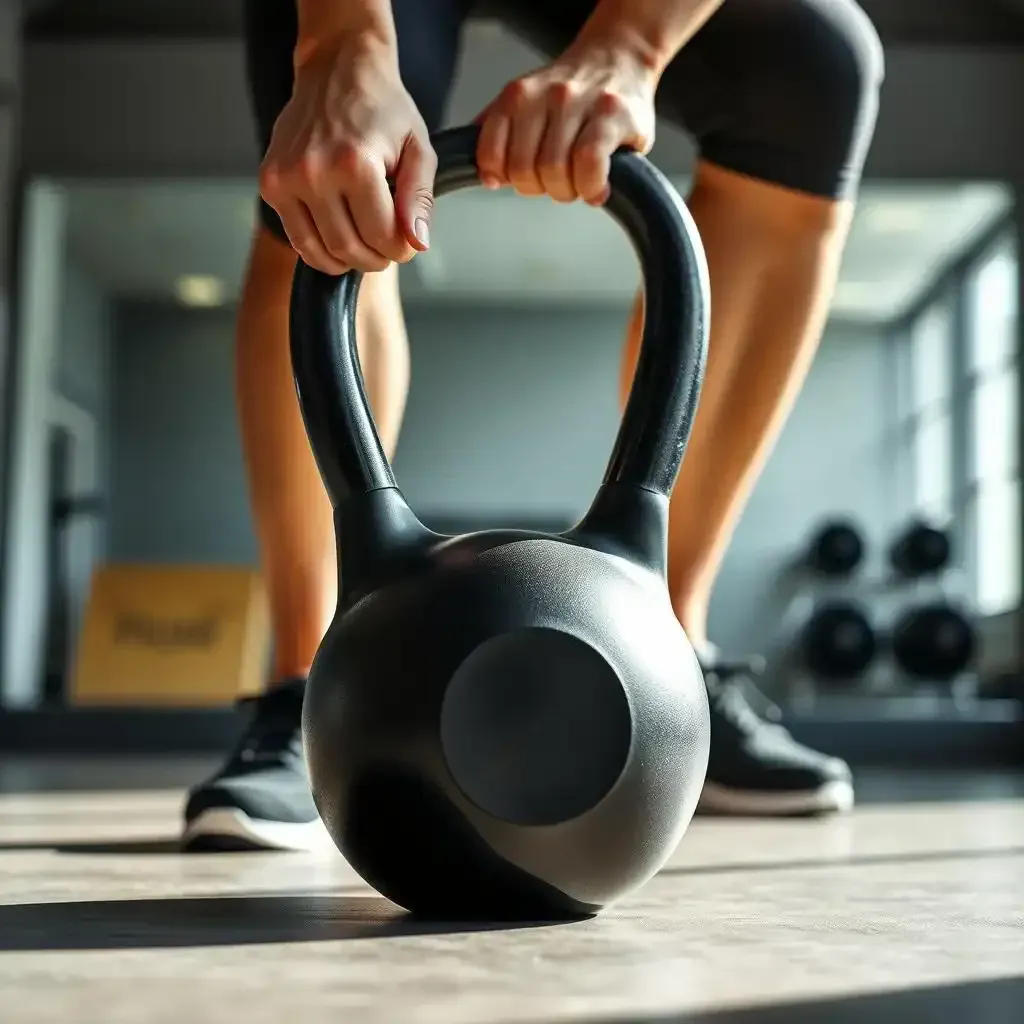Table of Contents
So, you're thinking about adding kettlebells to your workout routine? Smart move! Kettlebells can seriously boost your strength and fitness. But, let's be real, there's a flip side to that coin. Like any intense workout, using kettlebells comes with potential risks. We’re not trying to scare you, but knowing these risks, and more importantly, how to avoid them, is crucial. This article, created by kettlebellworkout.homes, will walk you through the common pitfalls of kettlebell training. We'll break down everything from proper form to choosing the right weight, so you can enjoy the awesome benefits of kettlebell workouts without ending up sidelined by an injury. We'll even throw in some real-life examples and tips to make this easier to understand. Get ready to learn how to make your kettlebell progression safe and effective! Remember, knowledge is strength, especially when it comes to your health. Let’s examine in!
Kettlebell Workout Risks: Avoiding Common Injuries

Kettlebell Workout Risks Avoiding Common Injuries
Understanding the Kettlebell: It's Not Just a Weight
Hey there, fellow fitness enthusiasts! Let's talk kettlebells. They're awesome for building strength and endurance, but they're not your average dumbbell. Think of a kettlebell as a mischievous little gremlin – powerful, but easily angered if you don't treat it with respect. A kettlebell's center of gravity is different. This means it challenges your balance and coordination more than a dumbbell. That's where the fun begins, but also where injuries can happen if you're not careful. I've seen people try to muscle their way through exercises, and it's never pretty. Remember that smooth, controlled movement is key. Think graceful ballerina, not a clumsy gorilla.
One common mistake? Picking a weight that's way too heavy. It's tempting to go big, but trust me, starting small and gradually increasing the weight is much safer. It's like learning to ride a bike – you wouldn't jump onto a motorcycle right away, would you? Start with a weight you can easily control, focusing on perfect form. Gradually increase the weight as you get stronger. For more guidance on choosing the right weight, check out our guide on choosing the right kettlebell weight.
Mistake | Solution |
|---|---|
Using a weight that's too heavy | Start light, focus on form, gradually increase weight. |
Ignoring proper form | Watch videos, get coaching, practice in front of a mirror. |
Not warming up | Prepare your muscles with dynamic stretching and light cardio. |
Common Injuries and How to Dodge Them
Let's get real: injuries happen. Even experienced athletes get hurt. But many kettlebell injuries are preventable. Back pain is a common culprit. It usually happens when people use their backs instead of their legs to lift. It's like trying to lift a piano with your teeth – not a good idea! Proper form is essential here; engage your core and legs to do the heavy lifting. Shoulder problems are another frequent issue, often due to poor form during swings and snatches. Again, slow and controlled movements are key. Think of your body as a finely tuned machine – treat it with respect and it'll reward you.
Wrist injuries are another common issue. Some people have weaker wrists than others. If you have weak wrists, consider using wrist wraps for extra support. Don't push yourself too hard, especially in the beginning. Remember, consistency is key. Small, consistent progress is better than sporadic intense workouts. For a more detailed breakdown of proper technique, check out our kettlebell form guide. It's full of tips and tricks to keep you safe and strong.
- Warm-up properly before each workout.
- Cool down and stretch afterwards.
- Listen to your body; pain is a warning sign. Don't push through it!
Understanding Kettlebell Mechanics to Minimize Risk

Understanding Kettlebell Mechanics To Minimize Risk
Okay, so you're ready to swing some kettlebells, huh? Awesome! But before you go all "Arnold Schwarzenegger" on us, let's talk about how these things actually work. Think of a kettlebell as a quirky little weight with a mind of its own. It's not just about brute strength; it's about balance, coordination, and a whole lot of controlled movement. That off-center weight is what makes kettlebells so effective, but it's also what can lead to injuries if you're not careful. I've seen people try to muscle through exercises, ending up looking like a wobbly giraffe trying to do ballet. It's not pretty, and it's definitely not safe. Remember, we're aiming for smooth, controlled movements. Think graceful dancer, not a runaway train.
One of the biggest mistakes newbies make is grabbing a kettlebell that's way too heavy. It's tempting to show off, I get it, but trust me, starting with a lighter weight and focusing on perfect form is the way to go. It's like learning to ride a bike – you wouldn't hop on a Harley-Davidson on your first try, would you? Gradually increase the weight as you get stronger. Check out our for more tips on choosing the right weight.
Body Part | Common Injury | Prevention Tip |
|---|---|---|
Back | Strain | Engage your core and legs; don't lift with your back. |
Shoulders | Pain, inflammation | Maintain proper form; avoid jerky movements. |
Wrists | Sprains | Use wrist wraps if needed; start with lighter weights. |
Another thing to think about is your grip. A solid grip is super important for safe and effective kettlebell training. If you have a weak grip, you're more prone to injuries. Practice your grip strength, and consider using straps if needed. It's not cheating; it's smart! A strong grip will help you avoid injuries and increase your overall performance. For more information on grip strength, check out our guide on improving your grip strength.
Remember, proper form is your best friend when it comes to avoiding injuries. Take your time, don't rush, and focus on each movement. If something feels off, stop and adjust. Your body will thank you for it. It's always better to err on the side of caution. We have plenty of resources to help you perfect your form. Check out our beginner’s guide to kettlebell exercises to learn more! Beginner Kettlebell Exercises
- Start with lighter weights.
- Focus on proper form.
- Listen to your body.
- Take breaks when needed.
Proper Form and Technique: The Key to Safe Kettlebell Workouts

Proper Form And Technique The Key To Safe Kettlebell Workouts
Mastering the Fundamentals: It's All About the Basics
Hey there, kettlebell newbies! Let's be honest, those things look intimidating. They’re like little iron cannonballs with handles, right? But trust me, once you get the hang of it, they're amazing. Think of proper form as your secret weapon against injury. It's not about how much weight you lift; it's about how smoothly you lift it. I’ve seen people try to strength through exercises, and, well, let's just say it doesn't end well. Think of yourself as a graceful dancer, not a clumsy weightlifter. Start with lighter weights, focusing on smooth, controlled movements. It's all about building that muscle memory and perfecting your technique before you crank up the weight. Remember, consistency trumps intensity.
Start slow. Seriously. Don't try to be a hero on your first day. Begin with a weight you can comfortably manage for 10-15 repetitions with perfect form. You can always increase the weight later, but you can't undo an injury. This is where our guide on kettlebell basics really shines. It's packed with videos and diagrams to help you nail that perfect form. We also have some killer beginner routines you can check out to get started: beginner kettlebell workout. These will help you build a solid foundation before you graduate to more advanced moves.
- Start with lighter weights.
- Focus on proper form, not speed or weight.
- Practice in front of a mirror.
Building Strength and Stability: Slow and Steady Wins the Race
Think of your body as a finely tuned machine. You wouldn't rev a brand-new engine to its max right away, would you? Same goes for your muscles. Building a strong core is crucial for kettlebell training. Your core acts like the anchor that keeps you stable and prevents injuries. Engage your core muscles throughout each exercise – I’m talking about your abs, lower back, and obliques. It's like having an invisible corset supporting your spine. This is where you'll find exercises to strengthen your core: Core kettlebell exercises and exercises for posture.
Another key element is your breathing. Don't hold your breath! Exhale during the exertion phase of the movement – that’s when you’re lifting or swinging the kettlebell – and inhale as you return to the starting position. This helps control your movements and prevents you from straining. Think of it like this: a controlled breath helps you control your body. And speaking of control, check out our guide on kettlebell technique for some extra tips and tricks.
Exercise | Breathing Technique | Muscle Focus |
|---|---|---|
Kettlebell Swing | Exhale during the swing, inhale on the return | Glutes, hamstrings, core |
Kettlebell Goblet Squat | Inhale before squat, exhale as you stand | Quads, glutes, core |
Kettlebell Workout Risks: Building a Safe and Effective Routine
Building a safe and effective kettlebell routine is like laying the foundation for a house. You want to make sure everything is solid and secure before you start swinging that heavy iron. So, where do you begin? Start by understanding the basics and gradually building up your strength and form. It’s all about starting slow and steady, not rushing into heavy weights or complex moves. Think of it as learning to walk before you run.
A key part of building a safe routine is warming up properly. Just like you wouldn’t go for a sprint without a warm-up, you shouldn’t investigate into kettlebell exercises cold. A good warm-up gets your muscles ready and reduces the risk of injury. Try some dynamic stretches and light cardio to get your blood flowing. For some great warm-up ideas, check out our guide on kettlebell warm-up exercises.
- Start with a light warm-up.
- Focus on dynamic stretches.
- Include some light cardio.
Another crucial aspect is listening to your body. If something feels off, it probably is. Don’t push through pain or discomfort. It’s better to take a break and reassess than to end up with an injury that sidelines you for weeks. Think of your body as a finely tuned machine. Treat it with care and it will reward you with better performance. If you need some tips on injury prevention, our kettlebell injury prevention guide is a great resource.
Consistency is also key. Regular, consistent workouts are more effective than sporadic, intense sessions. Aim for a few shorter workouts each week rather than one long, grueling session. This helps build strength and endurance without overwhelming your body. For a sample routine, check out our beginner kettlebell routines. These will help you get started on the right foot.
Workout Frequency | Workout Duration | Focus |
|---|---|---|
3 times a week | 20-30 minutes | Building strength and form |
4 times a week | 30-45 minutes | Improving endurance |
5 times a week | 45-60 minutes | Maximizing fitness gains |
Final Thought
Kettlebell workouts offer incredible fitness benefits, but safety should always be your top priority. By understanding the potential risks of kettlebell workout risks and diligently following safe practices, you can significantly reduce your chances of injury and enjoy a rewarding and injury-free fitness progression. Remember, starting slow, focusing on proper form, and listening to your body are your best allies in achieving your fitness goals safely and effectively. Happy lifting!